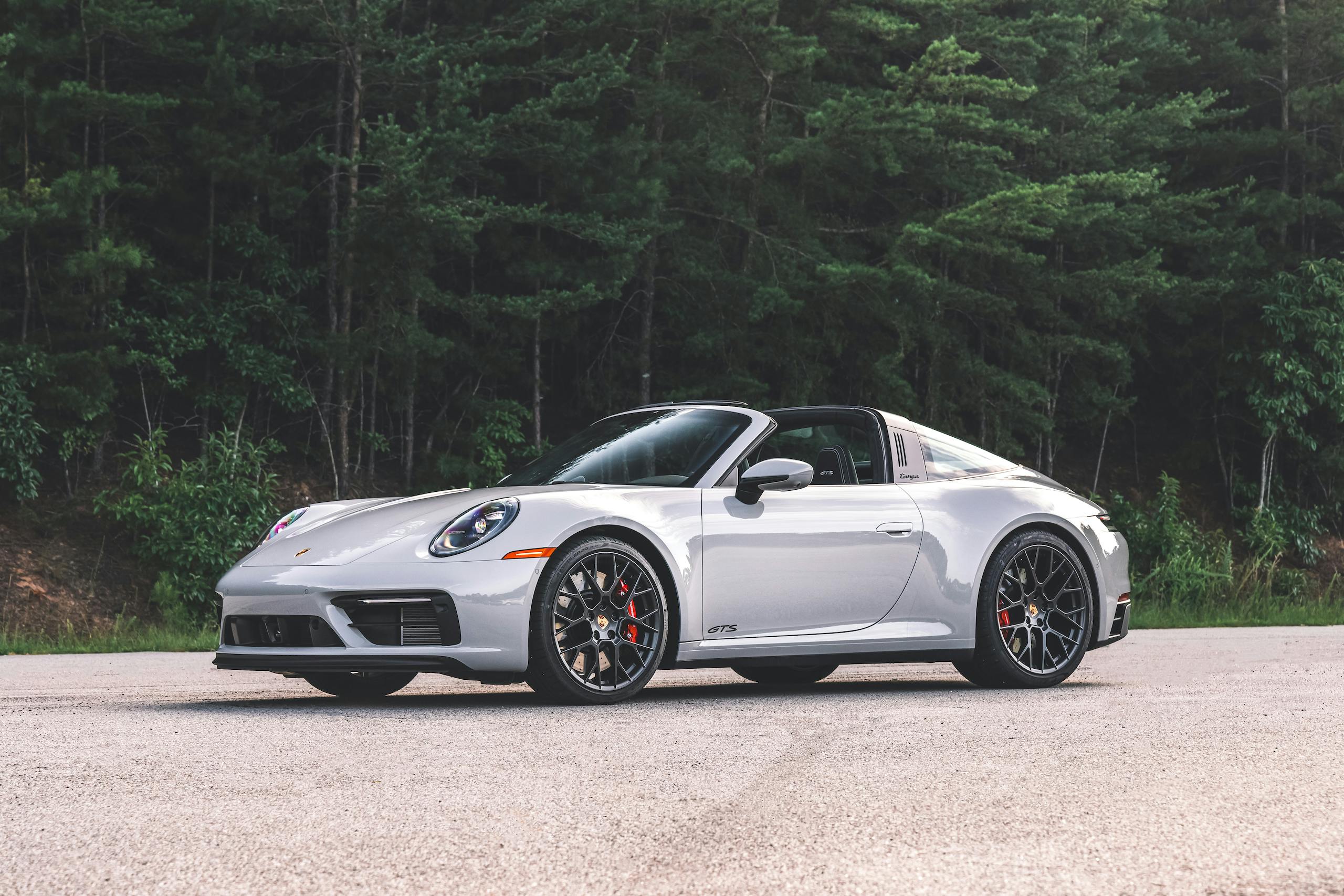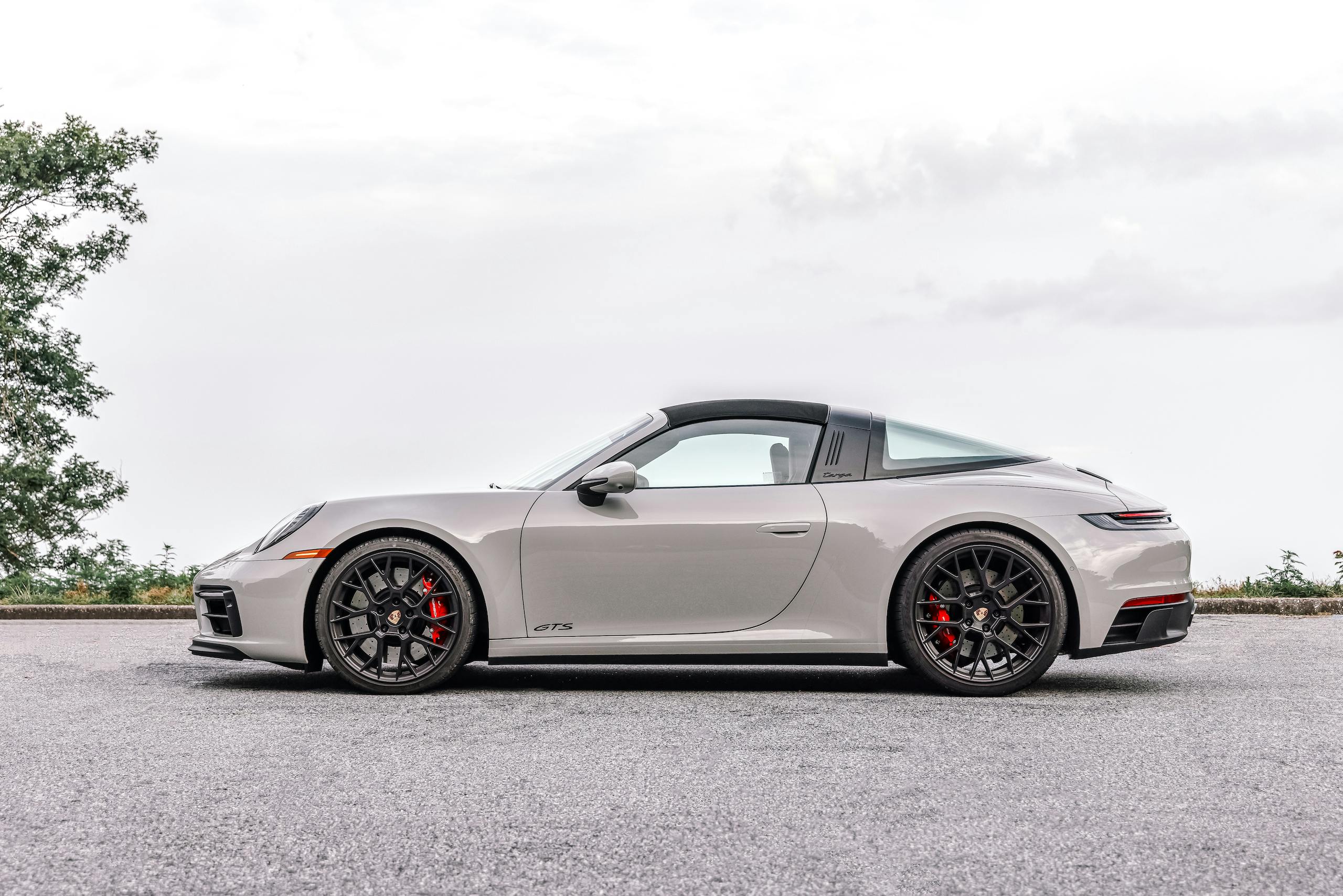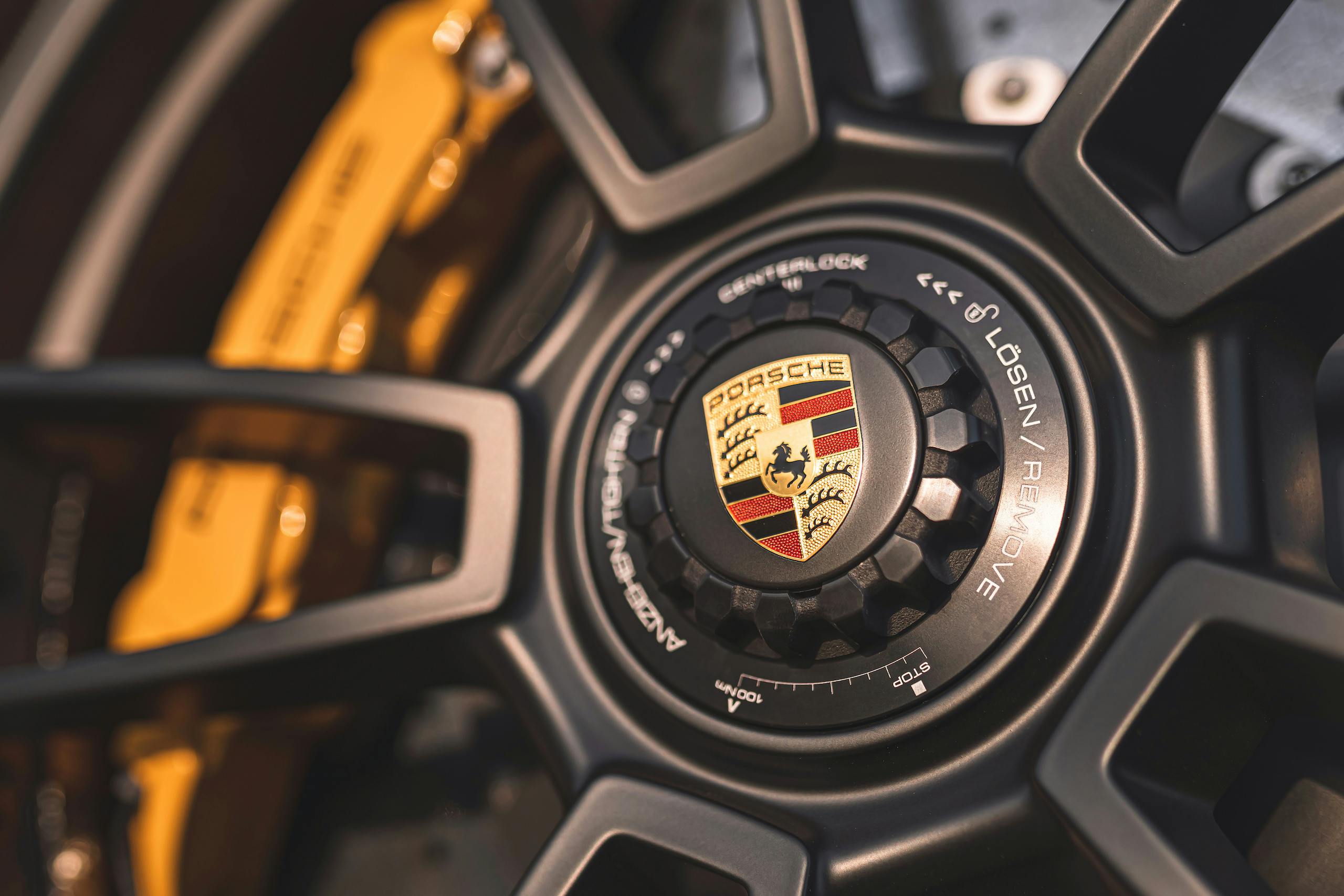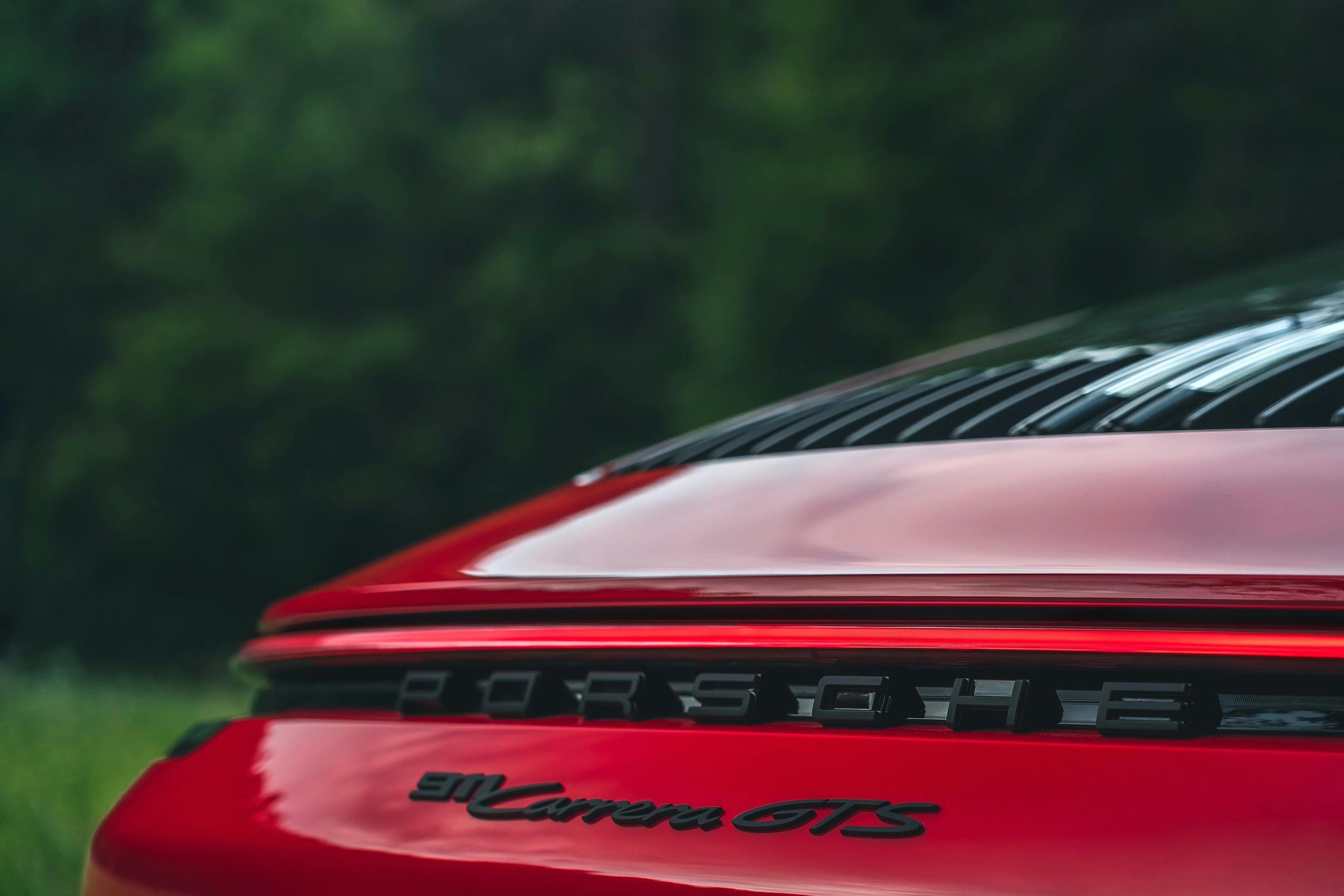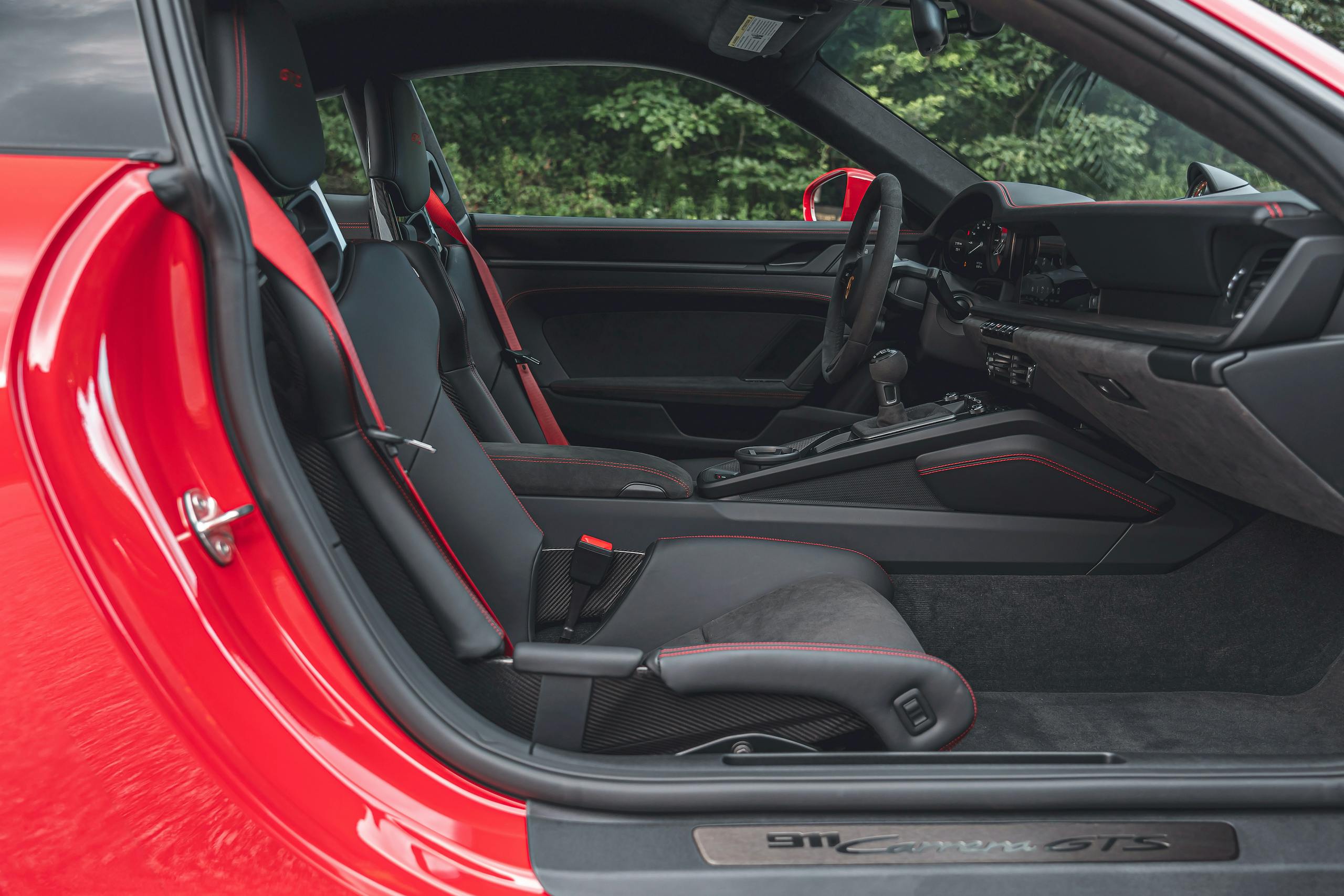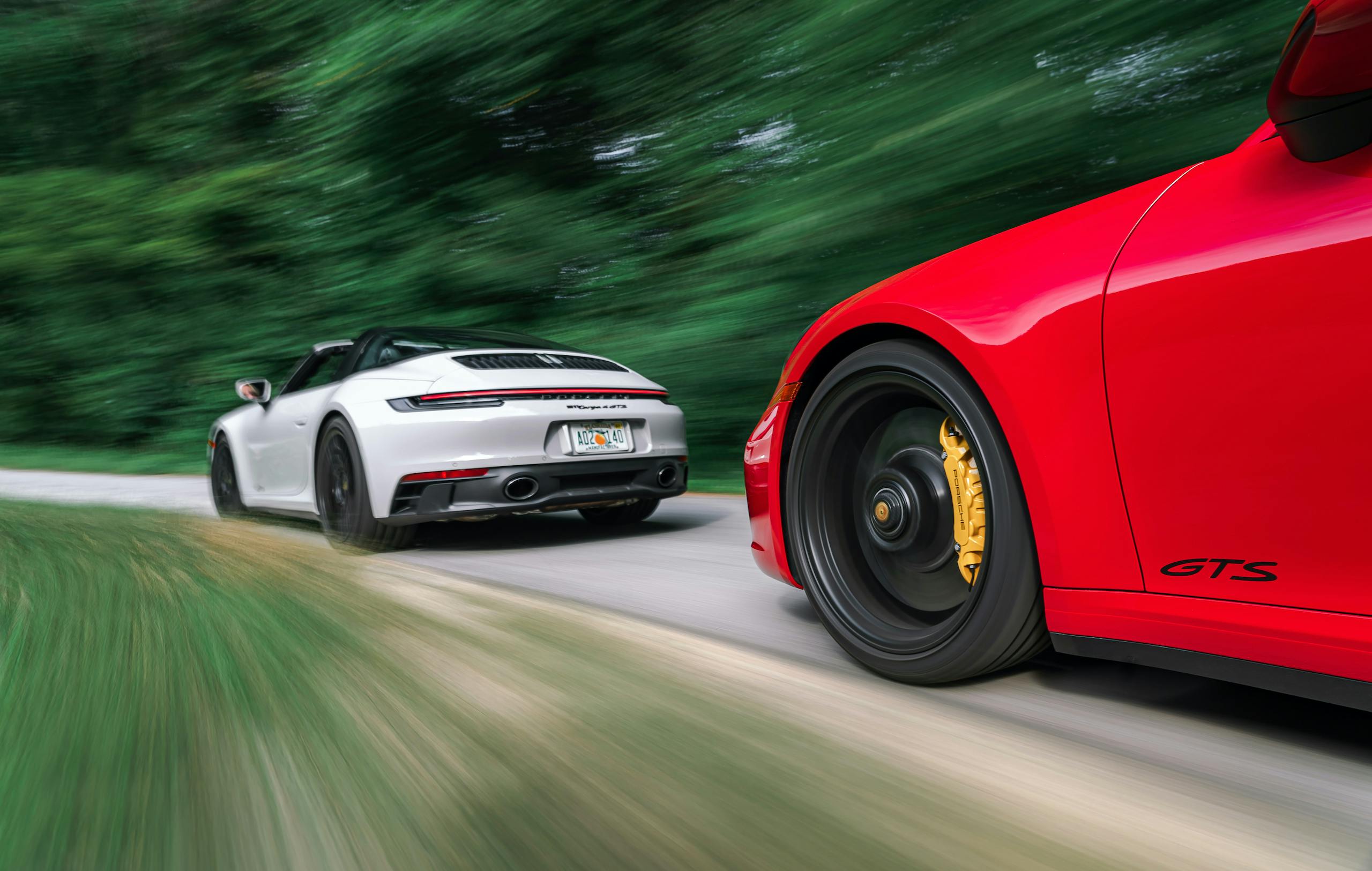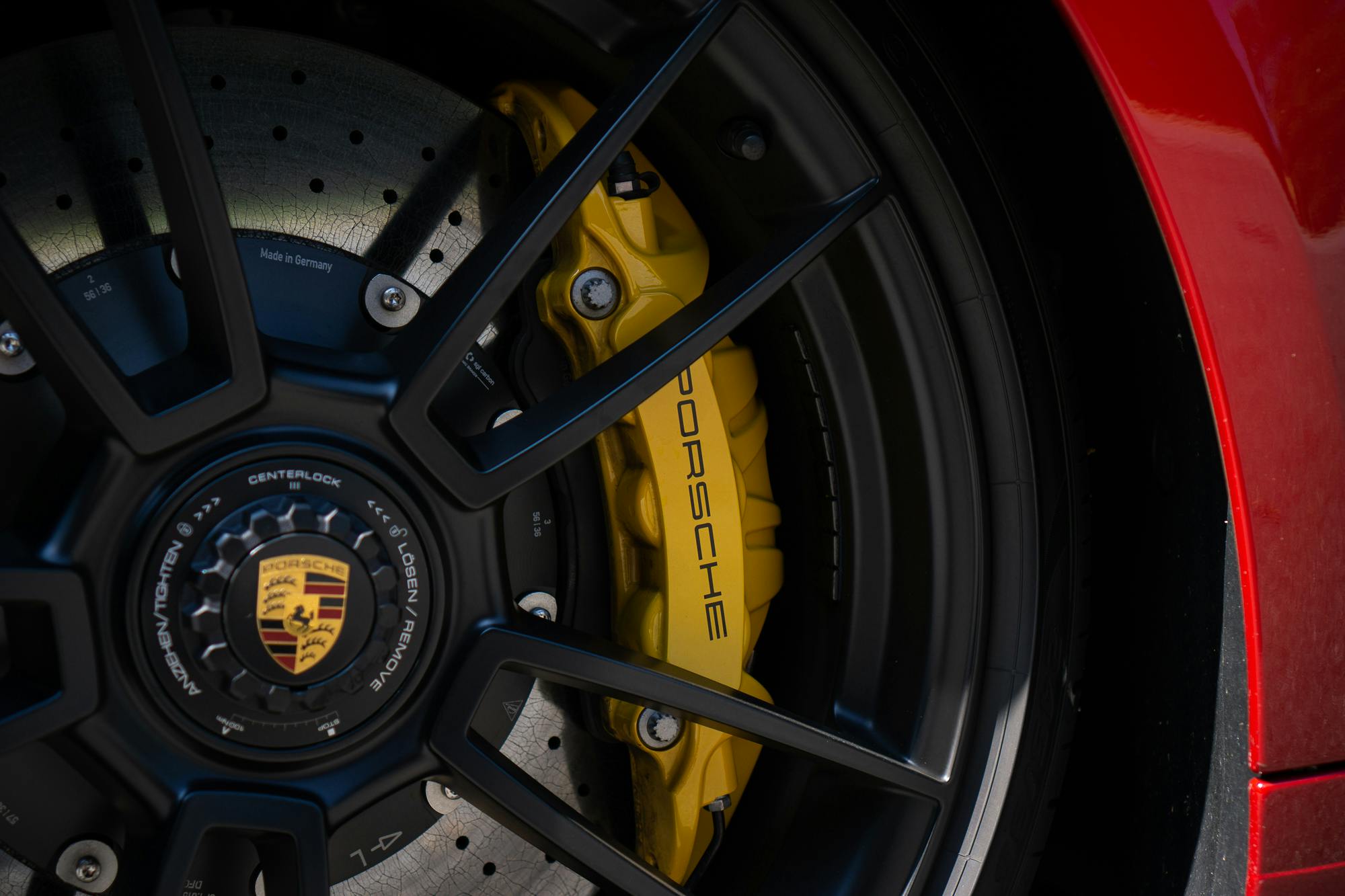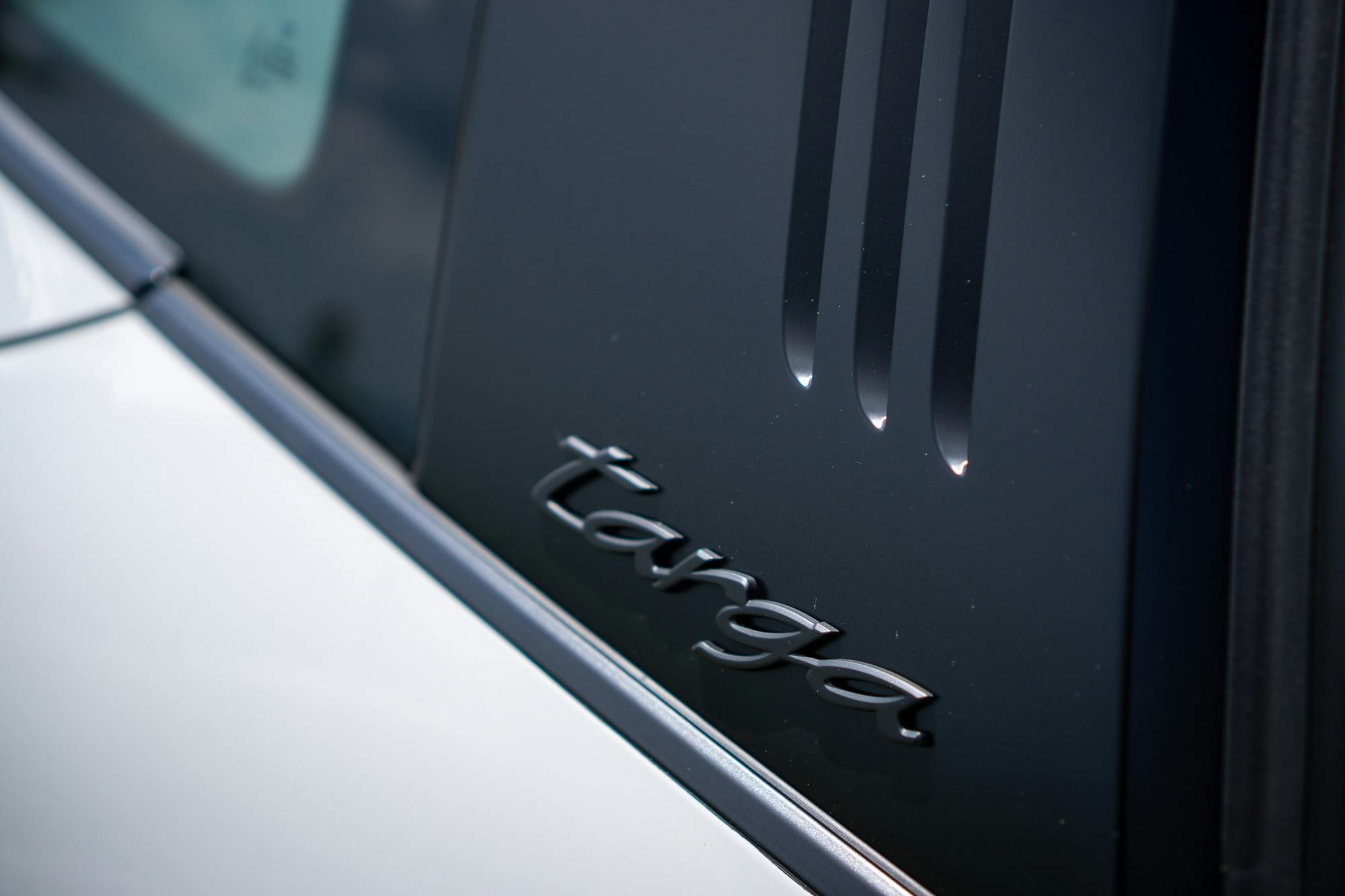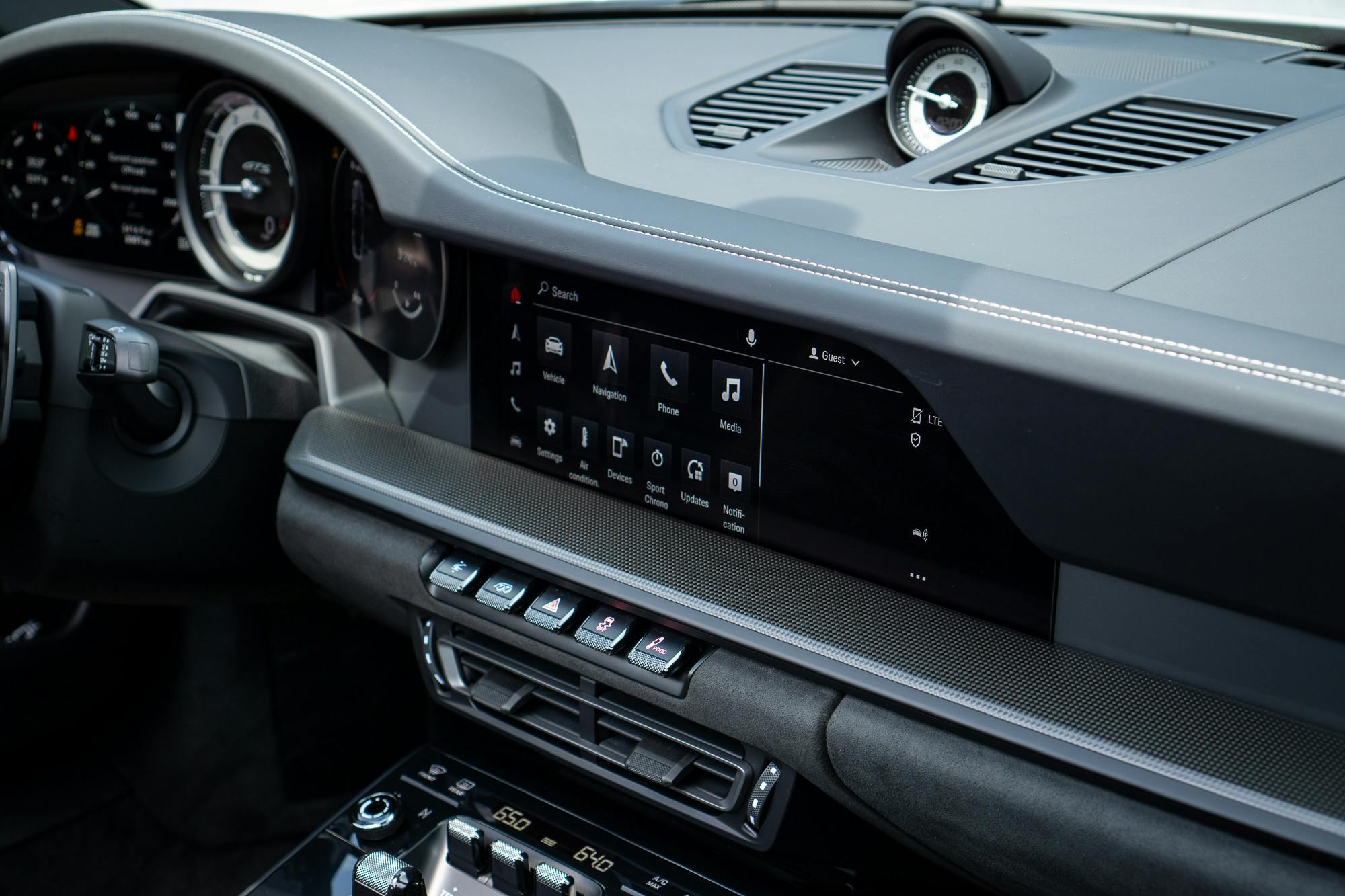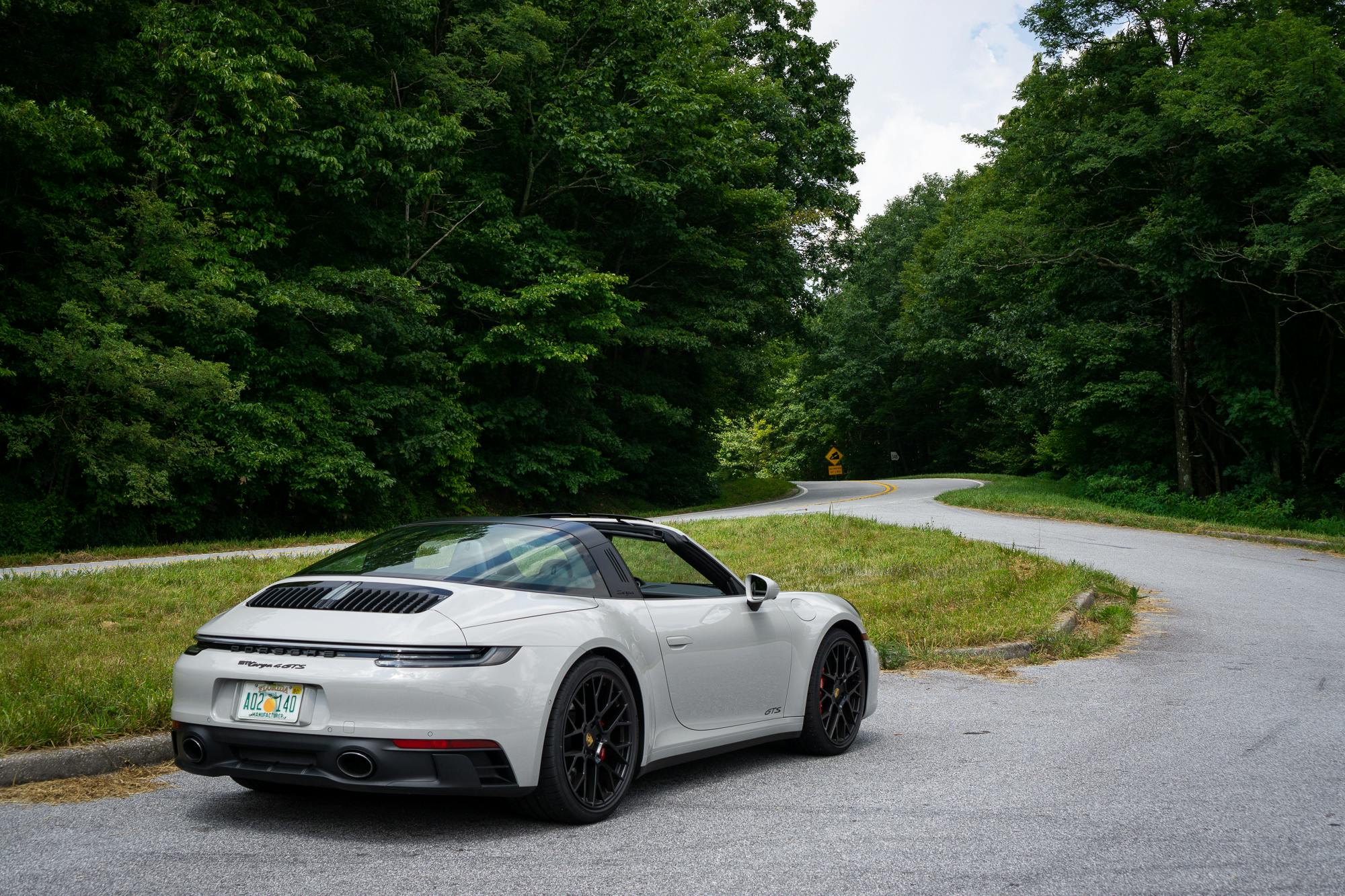Media | Articles
First Look Review: 2022 Porsche 911 GTS
After driving through dozens of sharp corners and gut-wrenching elevation changes, encountering a mountain vista has a way of settling the mind. We found that respite high in the hills of North Georgia, looking over the White Oak Stamp Gap at the hazy blue of the Appalachians. No cell service. Just the gentle white noise of radiator fans cooling the Porsche 911 GTS under the relentless heat of midday sun.
Then, the unmistakable shout of an aftermarket exhaust signaled a fellow motorist inbound. Out from the modified Infiniti G37 we met Wesley Walls, 18 and a bit scruffy, already a seasoned veteran of this road, the Richard B. Russell Scenic Highway. His dad taught him to drive up here when he turned 15. “It’s known for being one of the most dangerous mountain roads in the area because of all the places without guard rails,” he said. “No matter what kind of day I’m having, I drive it and I’m just relaxed, no other thoughts on my mind. Just me, the car, and the road.”
I looked to the Chalk-colored GTS next to me. Is this the sort of sports car that lets the whole world fade away?
We already know that Porsche is working on a hybrid-powered 911, which means this 992-generation lineup could be the last to exclusively feature piston power from frunk to tail. Porsche claims that this GTS model is the core of the 911 lineup, the variant around which the entire current roster was designed, engineered, and validated.
That makes sense when you remember that the GTS—available as either Coupe or Cabriolet with your choice of rear- or all-wheel drive, eight-speed PDK or seven-speed manual, as well as a AWD-only Targa—comes with a windfall of major performance options as standard. The haul includes active suspension with model-specific tuning and ride height 10 mm lower than stock (the Targa GTS gets the standard-height PASM system, rather than PASM Sport), massive brakes inherited from the 911 Turbo, and 20/21-inch center-lock Turbo S wheels, and Sport Exhaust painted black. PDK models come with an electronically controlled locking rear differential and torque vectoring (PTV+), while the manuals get a mechanical limited-slip unit. Inside you’ll find the smaller GT Sport steering wheel, standard two-way automatic Sport Plus seats, and the Sport Chrono package as standard. As for key boxes left unchecked, it comes down to the sporty GTS Interior Package, carbon-ceramic brakes ($9870), rear-axle steering ($2090), active anti-roll bars ($3170), and a smart front axle lift with GPS memory to avoid nasty front-end scrapes ($2770).
Marketplace
Buy and sell classics with confidence
Could one simply load up a Carrera S with the above standard equipment? Porsche will not balk if a customer wanted such a car, although doing so would constitute roughly $20,000 of additional cost, not to mention the omission of several important details exclusive to the GTS. Chief among them are those meaty 911 Turbo brakes, plus 30 more horsepower (and 30 lb-ft more torque) compared to the Carrera S, for a total of 473 hp and 420 lb-ft. That increase comes courtesy of 14.5 percent additional boost pressure, and a reinforced dual-mass flywheel is included to balance out the extra muscle. The GTS wears unique bumpers front and rear, with eye-catching black accents, and you can delete the black “GTS” script from the side sill and/or rear decklid. If you know, you know.
About that cost savings. When the GTS first launched for the 2011 Porsche 911 (997 gen), its main appeal was as a solid-performing, bargain-priced bridge between the Carrera S and the all-business GT3. It proved popular. So popular that a 911 buyer selects the GTS 15–20 percent of the time when available. Of course, as the 911 GT3’s performance envelope continues to expand, the GTS is rising up to fill the void and has increased commensurately in price. The $104,050 starting price in 2011 amounts to roughly $130,000 in today’s dollars, against the new model’s $138,050 starting price for the rear-drive Coupe. Our two test cars in Georgia were a rear-drive GTS Coupe totaling $178,440 and a Targa 4 GTS totaling $193,960—price territory that not long ago would yield you a modestly equipped 911 Turbo.
Granted, our build sheets featured a number of high-dollar options, but it’s those very options that allow customers to build the best-equipped, most driver-focused 911 this side of the GT3. So for those with neither the allocation nor the chiropractor hook-ups to obtain and live with a GT3, the GTS is about as good as it gets for the 911—particularly in North America where the Autobahn supremacy of the Turbo S is wasted. Though it’s hard to consider the GTS much of a value play anymore, on paper it’s still stuffed with every ingredient to transform it into the ultimate daily-driver Carrera.
Back on Richard B. Russell Scenic Highway, the Carmine Red Carrera GTS Coupe we drove presents a compelling case that Porsche hasn’t botched the recipe. So equipped (carbon-ceramic brakes, rear-axle steering, active anti-roll bars, manual transmission, and full carbon bucket seats with rear-seat delete that can be ordered as part of the Lightweight Package that shaves 55 pounds) this car’s genius is the harmony of the driving experience. We marched up the twisty mountain pass, running the the engine to redline each of the first three gears before we remembered to check the speedometer’s rather unmentionable readout. Highlanders and Wranglers are gone from view in moments, their gas tanks seemingly filled with rhino tranquilizer. Or maybe liquid cement. There’s simply more front end grip on tap here than any sane person can challenge on public roads.
There’s plenty to keep you entertained, though. The steering is heavy but not artificially so, and it’s surgically precise. The clutch is a little heavy too—springy, and enjoyable to engage—and the shortened gear lever makes for snappy shift action. Brakes are right-now reliable especially when heated up, but even once cool exhibit none of the annoying hyper-response of most carbon-ceramics. The real surprise, however, is the Auto-Blip rev-matching feature, which nails every downshift. And in the instances where we wanted to work the pedals ourselves for a little heel-toe, the system had enough respect to make itself scarce. Or you can simply configure it to turn off in any drive mode.
Throttle response in Normal mode is a touch lazy, but turn the steering wheel dial up one notch to Sport and the 3.0-liter engine becomes urgent, forceful even, building speed predictably to its 7500 rpm redline. The flat-six sound is pleasant, and the Sport Exhaust spits none of the crass computer-controlled pops you get from the F-Type’s exhaust. But a GT3’s naturally-aspirated 4.0-liter this is not. The trusty plateau of turbo torque is firmly in the mid range, from 2300–5000 rpm, where you can count on the strongest shove, but even at the 3.0-liter’s top end it doesn’t sound like automotive angels singing.
No matter. Carrying speed is so effortless, while inputs to the steering, throttle, and brake yield such smooth response, that it’s easy to forget what a large car the 911 has become. It turns in with confidence and eagerness. Settles assuredly from big elevation drops with neither a brutal bump-stop smack nor latent undulation—a function of those rear helper springs. The amount of computer-controlled trickery going on never shows its hand, and that is the beauty of it all. A highly complex suite of invisible aids that let you safely dance at the edge of the volcano without fear of magma death.

The Targa model is impressive, albeit noticeably less joyful. Despite exposure to the elements with the top open, everything feels muted. Dialed down. One obvious culprit here is weight—the unavoidable consequence of all-wheel drive, PDK, and the Targa’s intricate roof system. Add to that the standard, 10-mm taller suspension and lower spring rate than the Coupe and Cab, and it’s obvious after a few corners that the Targa is set up for a more relaxed kind of year-round driving enjoyment, particularly in snowy climates where winter tires would be used.
Both examples, however, should be commended for their ability to serve as competent daily drivers. On Atlanta’s heavily trafficked highways, amid several construction zones, the GTS’ suspension was reasonably compliant, comfortable even, that it would be viable as a primary commuter. The base 911 is no doubt friendlier in this regard, but it doesn’t get the heart pumping like the GTS does when provoked. The GTS Interior Package’s contrasting color scheme and use of Alcantara elevates the feeling of bespokeness from the driver’s seat, but even without it the 911’s cabin is fundamentally an easy place to inhabit. The materials are high-quality. Physical buttons or knobs are included for essential functions like climate and radio, as well as for suspension settings, driving modes, and exhaust noise. There is nothing hokey or supercar-ish here, despite the fact that the all-wheel-drive GTS can bang off launch-controlled 3.3-second 0–60 sprints with exceptional ease and consistency. A similarly equipped coupe can do it in 3.1 on its way to a 193-mph top speed.
If we have any complaints, it’s that the steering wheel rim completely blocks the screens of the gauge cluster. (Yes, it is possible to call up a simplified view with a narrower scope, but that isn’t an excuse.) Beyond that our only other gripe is admittedly trivial: In both cars our iPhone overheated while plugged in and sitting in the center console—perhaps a symptom of searching for signal up on the mountain. The bucket seats are overkill for daily use, but they’re no doubt satisfyingly snug. In fairness, if you’re spending $5900 to consciously omit rear seats, you know what you’re getting into.
By now, you’ve probably figured out that the 911 GTS, particularly the rear-drive Coupe, passes the Wesley Test with flying colors. By his benchmark, if you can drive Richard Russell’s 14 miles hard and only using engine revs to scrub speed, you can drive just about anywhere. We confess to using the brake pedal more than once. But if we must return to North Georgia for practice, there are few cars we’d rather take there and back than the 911 GTS.
2022 Porsche 911 GTS
Base price/As tested: $138,050/$178,400 (2WD Coupe); $158,150/$193,960 (AWD Targa)
Highs: Powerful, confidence-inspiring, and rewarding to push hard. Supercar performance in a livable wrapper.
Lows: Not the bargain it once was, options can be seriously pricy. Cluster screens are an obvious miss in an otherwise ergonomically brilliant interior.
Summary: The king of today’s 911 Carreras, the GTS is a remarkable sports car that feels of one piece and without compromise.



















